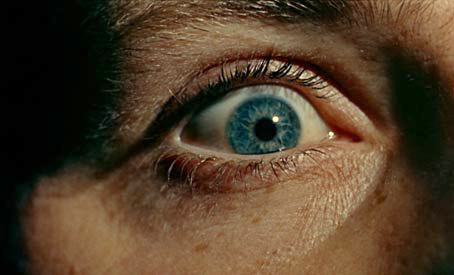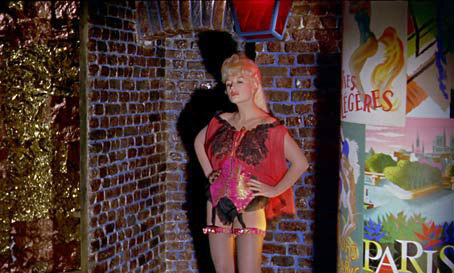|
I have, I'll admit, a soft spot for great opening shots, or maybe I should say distinctive and purposeful opening shots. A computer-generated whiz through the galaxy to land on a close-up of a bluebottle is all well and good, but if it's just to show off the technical skills of the effects crew and get the director's name on the Hollywood pick list then frankly you can keep it. It's not that I'm averse to technical showing off – the insanely complicated opening sequence of Touch of Evil still provokes a frisson of excitement (as long as it's accompanied by that Mancini score – sorry Orson, but it works divinely) – but I get an even bigger kick from those movie openings that completely reverse the traditional establishing wide and start with a close-up. There's something irresistible about not knowing what you're looking at or what its relationship will be to what follows, the first puzzle piece of a picture that will be revealed from the inside out, and a hook for the viewer who prefers to work a little for their entertainment.
Vertigo is a great example. The screen opens on the frankly bemusing shot of a horizontal bar, an abstract image that the music is telling us to get excited or apprehensive about. No-one I know had a clue what they were looking at on their first viewing of the film, at least until two hands reach up and grab it and the camera retreats to reveal that the bar is the rung of a ladder leading to rooftop, onto which a fleeing criminal and two pursuing policemen climb. It's a marvellous start, pulling you in from the opening frames and plunging you into a sequence that's actually close to its conclusion, one that economically introduces the lead character and establishes the source of his crippling phobia.
But as such opening shots go, Michael Powell's legendary Peeping Tom is probably my favourite, a huge close-up of a closed eye that, in time with an off-key music twang, springs open faster than any human eye could, a trick of frame trimming that transforms an everyday action into something startling and potentially menacing. And if you enjoy getting subtextual then there's a small essay in that one shot alone in how it connects to what follows, in the relationship between the eye and the camera lens, in the issue of contemporary censorship, in the horror genre's trait of showing you things that in real life you would shy away from, and a whole lot more. See it on a large cinema screen and the impact is multiplied to the degree that it makes you physically jump.

Peeping Tom was, of course, the film that effectively finished the career of one of our very greatest filmmakers. The late Alexander Walker went on record to claim that the critical response had little or nothing to do with this, but in interview Powell himself told a very different story, recalling being hauled before a panel of hostile critics, who proceeded to lambaste the film and demand to know how he had dared to make it. Critic Derek Hill even said of the film on its release, "The only really satisfactory way to dispose of Peeping Tom would be to shovel it up and flush it down the nearest sewer. Even then the stench would remain." It remains a painful irony that just a few months later another low budget serial killer film from a celebrated British filmmaker, a certain Alfred Hitchcock, became a box-office sensation and bolstered the reputation of its director to new heights.
As is often the way, time has seen Peeping Tom's reputation soar and deservedly so. This is a rare film that is as thematically complex and cinematically thrilling as it is unsettling, one whose portrait of its killer was years ahead of its time, and whose interlinking of cinema, voyeurism, pornography and murder have remained unequalled to this day.
If you're new to Peeping Tom then I can do no better than point you in the direction of fellow writer Camus's detailed review of the film and the previous DVD release here, as while I could wax lyrical for some time on the film, much of what I'd have to say has been better said there.
What I will comment on briefly is the enigmatic title, an almost playful and very British term for voyeur (Peeping Tom was the name given to the person who was struck blind after watching Lady Godiva on her naked horseback ride through Coventry) that gives no indication of the horrors that lay within. The title is now so closely associated with the film that it's easy to forget the difficulty it must have posed for foreign market distribution, where the term Peeping Tom had no real meaning. This resulted in some fascinating and usually more salacious title changes, including Face of Fear in America, A Vítima do Medo (The Victim of Fear) in Portugal, El fotógrafo del pánico (The Photographer of Panic) in Spain, L'occhio che uccide (The Eye That Kills) in Italy, Tres rostros para el miedo (Three Faces of Fear) in Argentina, and my personal favourite from Japan, Chi wo sû kamera, or The Camera That Sucks Blood.
For those of you who already have that disc or the US Criterion release that preceded it, the question is going to be whether Optimum's new Blu-ray disc is worth the upgrade. Which brings us nicely to...
More than once I've seen Peeping Tom's colour scheme described as being akin to the look the pornographic photos of the period, the very images that leading man Mark Lewis is employed in his spare time to shoot. This means that the colour is rarely natural in the usual sense of the term, with faces frequently tinted by filtered light, and costumes and fittings seemingly chosen as much for their colour as their practical value (this is especially true in the upstairs photographic studio in which Mark plies his second trade). This colouration is clearly deliberate (few filmmakers knew how to use colour like Powell) and is vividly captured here, from the rich reds of Mark's screening room and the studio at night to the eye-popping primes on the sets and costumes in in the upstairs studio. On the whole it feels 'warmer' than the DVD transfer – which of the two is more accurate to Powell's original intentions is a hard one to call. There is some visible variance in the sharpness and contrast finesse of the material, with the detail in some shots a little softer than you might expect – the sequence when Helen first emerges from Mark's screening room and asks him about his father is a prime example, with neither the actors nor the surroundings having the crispness you'd normally expect from Blu-ray, even of a film of the period. This is likely down to some variance in the quality of the pre-restoration material (I realise I'm making excuses here, but the included restoration featurette seems to confirm this), and just as the aforementioned opening close-up delivers the film's first visual jolt, it also here provides up-front evidence of the quality of the transfer and the picture detail at its best – every eyelash, facial hair and skin texture is beautifully captured, making the image even creepier than it was on the DVD. The print is pretty much spotless, and the black levels are spot-on with a minimal sacrifice of shadow detail (again, see the restoration featurette for evidence). And as so often with well transferred HD material, there's a richness to the picture that you could almost hug. Pleasingly, given the current trend for cropping prints to fit the 16:9 frame, the original 1.66:1 aspect ratio has been retained. On the whole, a handsome job.

The Linear PCM mono 2.0 soundtrack is clear, distortion free and betrays not a trace of damage or background hiss. The inevitable restrictions in the dynamic range feel right for the period and are in no way a problem. Optional English subtitles for the hearing impaired are also available.
This is in effect an HD upgrade of Optimum's previous DVD release, and the majority of the extra features here have been transferred over from that disc, the details of which you can find on Camus' DVD review here. Although most of them are standard definition 576p, they all look good and the content is as valuable as it ever was. They also feature a few standard def clips from the film for comparison purposes, which really emphasise the quality of the main feature's HD transfer. The trailers for other Optimum releases that were on the DVD are not present here.
What has been remastered in 1080p is the Trailer (2:27), which is clean of damage and dirt and looks rather lovely, if not quite as crisp as the main feature, although the "Look Out!" graphics are garishly sharp.
The single new feature here is a Restoration Comparison (6:13), which splits clips of the film down the middle to show the more washed-out and dust speckled print side-by-side with the restored one. What becomes clear here is that shadow detail that looks to be the victim of crisper black levels was for the most part not there in the pre-restored print either.
If you don't already own a copy of Peeping Tom then put this on your shopping list immediately. It has all of the extras from the DVD release but the best transfer yet of one of the most visually striking films of the period. If you have the DVD version then the decision on whether to upgrade will lie solely with your AV setup and just how highly you regard this film. If you're a devotee then you're going to want it looking its best, and within the above-detailed restrictions, Optimum's Blu-ray delivers. Recommended.
|